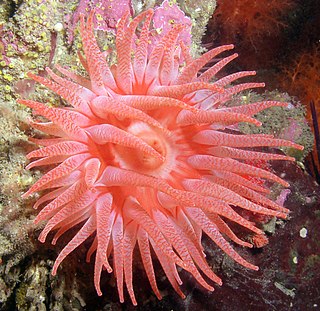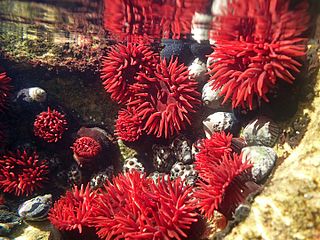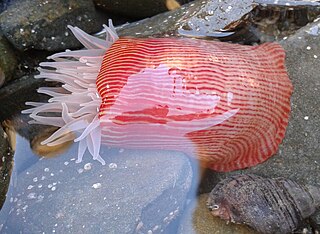
Heteractis magnifica, also known by the common names magnificent sea anemone or Ritteri anemone, is a species of sea anemone belonging to the Stichodactylidae family native to the Indo-Pacific area.

The sebae anemone, also known as leathery sea anemone, long tentacle anemone, or purple tip anemone, is a species of sea anemone belonging to the family Stichodactylidae and native to the Indo-Pacific area.

Cribrinopsis fernaldi, also known as the crimson anemone, snakelock anemone, chevron-tentacle anemone and Fernald brooding anemone, is a sea anemone native to the Pacific Ocean off northwestern North America.
Fernald brooding anemone may refer to two different species of sea anemone:

Urticina crassicornis, commonly known as the mottled anemone, the painted anemone or the Christmas anemone, is a large and common intertidal and subtidal species of sea anemone. Its habitat includes a large portion of the coastal areas of the northern hemisphere, mainly polar regions, and it lives a solitary life for up to 80 years. Mottled anemones are similar to Dahlia anemones and both are commonly referred to as northern red anemones.

Sea anemones are a group of predatory marine invertebrates constituting the order Actiniaria. Because of their colourful appearance, they are named after the Anemone, a terrestrial flowering plant. Sea anemones are classified in the phylum Cnidaria, class Anthozoa, subclass Hexacorallia. As cnidarians, sea anemones are related to corals, jellyfish, tube-dwelling anemones, and Hydra. Unlike jellyfish, sea anemones do not have a medusa stage in their life cycle.

Actinia tenebrosa, commonly known as the waratah anemone, is the most common species of sea anemone found in the waters of eastern Australia and New Zealand. It is found relatively high on the seashore, in rock pools, and various cracks and shaded surfaces such as under rock overhangs in the intertidal zone.

Epiactis prolifera, the brooding, proliferating or small green anemone, is a species of marine invertebrate in the family Actiniidae. It is found in the north-eastern Pacific. It has a feature rare among animals in that all individuals start life as females but develop testes later in their lives to become hermaphrodites.

Epiactis is a genus of sea anemones in the family Actiniidae. There are about nineteen recognised species and the type species is Epiactis prolifera.

Metridium farcimen is a species of sea anemone in the family Metridiidae. It is commonly known as the giant plumose anemone or white-plumed anemone. It is found in the eastern Pacific Ocean from Alaska down to Catalina Island, California.
Actinia bermudensis, the red, maroon or stinging anemone, is a species of sea anemone in the family Actiniidae.

Leptasterias hexactis is a species of starfish in the family Asteriidae, commonly known as the six-rayed star. It is found in the intertidal zone of the western seaboard of the United States. It is a predator and is unusual among starfish in that it broods its eggs and young.

Lebrunia neglecta is a species of sea anemone in the family Aliciidae. It is found in the Caribbean Sea and Gulf of Mexico.

Lebrunia coralligens, commonly known as the hidden anemone, is a species of sea anemone in the family Aliciidae. It is found in shallow water in the Bahamas, the Caribbean, and Brazil. It lives in fissures in corals and rocks.

Daphne Gail Fautin was an American professor of invertebrate zoology at the University of Kansas, specializing in sea anemones and symbiosis. She is world-renowned for her extensive work studying and classifying sea anemones and related species. A large sea anemone-like cnidarian species has been named in her honor, originally called Boloceroides daphneae, but recently renamed to Relicanthus daphneae, after it was discovered to belong to a previously unknown cnidarian order. Fautin has published numerous scientific articles and texts—including co-authoring Encyclopædia Britannica's entry on cnidarians—and her publications have been widely cited by other researchers in the field. Among her current positions, she is the curator of the University of Kansas Natural History Museum and serves as vice president and commissioner of the International Commission on Zoological Nomenclature, overseeing the naming of new species.
Anthopleura thallia, commonly known as the glaucous pimplet, is a species of sea anemone in the family Actiniidae. It is found in shallow water in the northeastern Atlantic Ocean and the Mediterranean Sea.

Epiactis thompsoni, the red-striped anemone, is a species of marine invertebrate in the family Actiniidae, found in New Zealand and South Australia. They are commonly found in the rocky intertidal zone.

Gonactinia is a monotypic genus of sea anemones, and G. prolifera is the only species in the genus. It is sometimes called the storey anemone and is found on either side of the northern Atlantic Ocean.
Epiactis ritteri, the sandy anemone or Ritter's brooding anemone, is a species of sea anemone in the family Actiniidae. It is found in the Pacific Ocean on the western coast of North America in the shallow sub-littoral zone.
Epiactis lisbethae, commonly known as Lisbeth's brooding anemone, is a species of sea anemone in the family Actiniidae. It is similar in appearance to the common brooding anemone, and like it is native to shallow waters on the western coast of North America.














